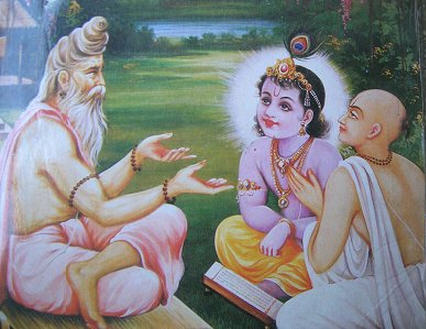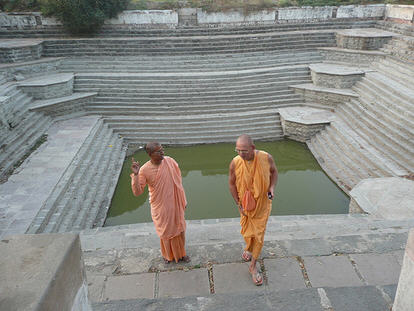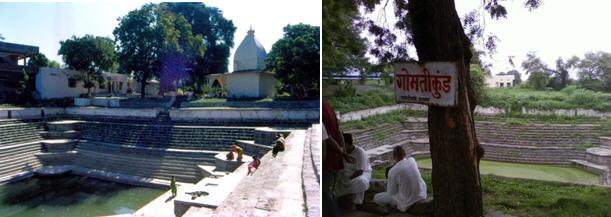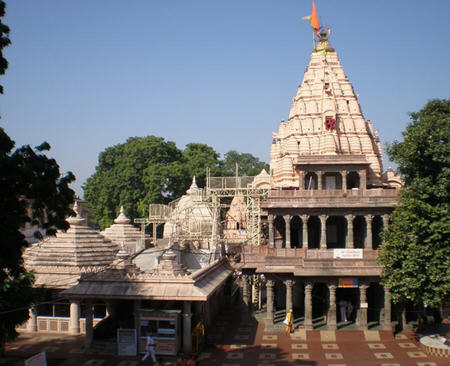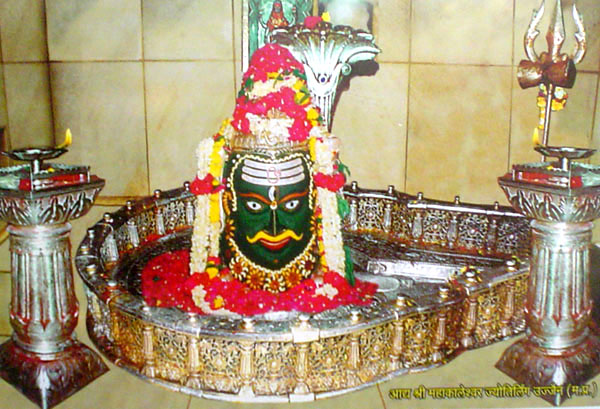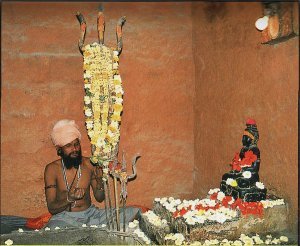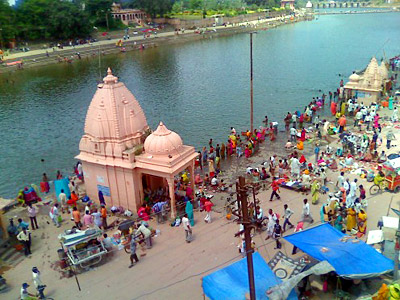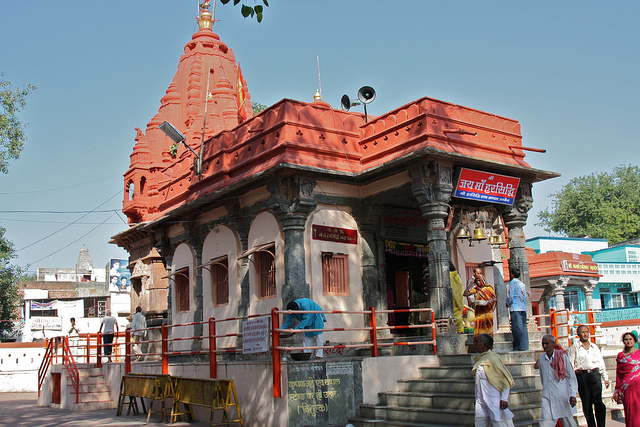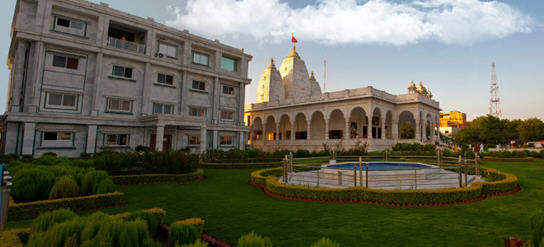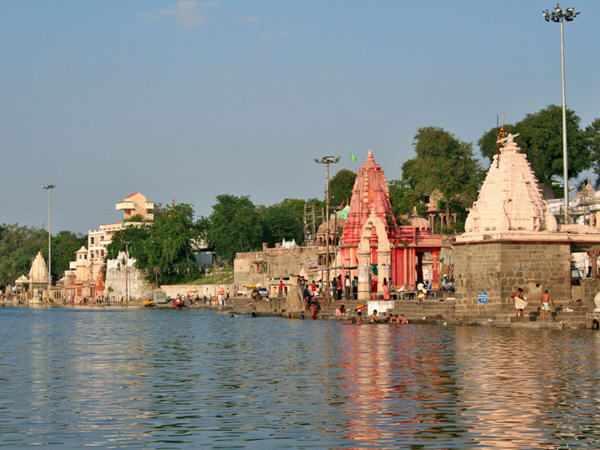a) Lord Krishna Marries Mitravinda.
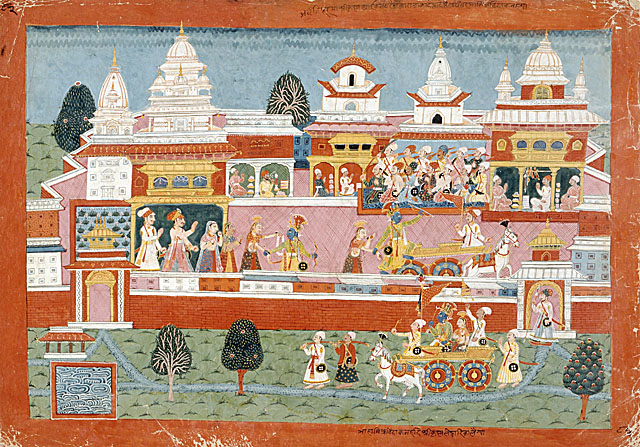
The kings of Avantipura (now known as Ujjain) were named Vindya and Anuvindya. Both kings were under the control of Duryodhana. They had one sister, named Mitravinda, who was a very qualified, learned and elegant girl, the daughter of one of Krsna’s aunts. She was to select her husband in an assembly of princes, but she strongly desired to have Krsna as her husband. However both her brothers did not favour her choice. During the assembly for selecting her husband, Krsna was present, and He forcibly carried away Mitravinda in the presence of all the other royal princes. Being unable to resist Krsna, the princes were left simply looking at one another. This story is similar to kidnapping of Rukmini.
b) The Avanti Brahman mentioned in Srimad Bhagavatam 11th canto.
This chapter tells the story of a mendicant sannyasi from the Avanti country as an example of how one should tolerate the disturbances and offenses created by evil persons.
The harsh words of uncouth persons pierce the heart even more severely than arrows. Yet a mendicant brahmana from the city of Avanti, even while being attacked by wicked men, considered this trouble to be simply the consequence of his own past deeds and tolerated it with utmost sobriety. Previously the brahmana had been an agriculturalist and merchant. He had been extremely greedy, miserly and prone to anger. As a result, his wife, sons, daughters, relatives and servants were all deprived of every kind of enjoyment and gradually came to behave unaffectionately toward him. In due course of time, thieves, family members and providence took away the sum total of his wealth. Finding him without any property and abandoned by everyone, the brahmana developed a deep sense of renunciation.
He considered how the earning and preservation of wealth involve great effort, fear, anxiety and confusion. Because of wealth, there arise fifteen unwanted items-thievery, violence, lying, deception, lust, anger, pride, feverishness, disagreement, hatred, distrust, conflict, attachment to women, gambling and intoxication. When this meditation arose in his heart, the brahmana could understand that the Supreme Lord SriHari had somehow become satisfied with him. He felt that only because the Lord was pleased with him had the apparently unfavorable turn of events in his life occurred. He was grateful that a sense of detachment had arisen in his heart and considered it the factual means for delivering his soul. In this condition he determined to engage the duration of his life in the worship of Lord Hari and thus accepted the mendicant order of tridandi-sannyasa. Subsequently, he would enter different villages to beg charity, but the people would harass and disturb him. But he simply tolerated all this, remaining firm as a mountain. He remained fixed in his chosen spiritual practice and sang a song renowned as the Bhiksu-gita.
Neither mortal persons, the demigods, the soul, the ruling planets, the reactions of work nor time are the causes of one’s happiness and distress. Rather, the mind alone is their cause, because it is the mind that makes the spirit soul wander in the cycle of material life. The real purpose of all charity, religiosity and so forth is to bring the mind under control. A person who has already composed his mind in meditation has no need for these other processes, and for a person who is incapable of fixing his mind they are of no practical use. The false conception of material ego binds the transcendental soul to material sense objects. The Avantibrahmana therefore became determined to bring himself over the insurmountable ocean of material existence by rendering service to the lotus feet of the Supreme Lord, Mukunda, with the same perfect faith in the Lord exhibited by the great devotees of the past.
Only when one can focus his intelligence on the lotus feet of the Supreme Personality of Godhead can the mind be completely subdued; this is the essence of all practical prescriptions for spiritual advancement.
c) Lord Shiva defeats Tripurasura :The religious tradition links it to Lord Shiva triumphing over the demon Tripurasura and then renaming the city from Avantika to Ujjainiyini (meaning ‘conquers with pride’).
Lord Siva Destroys Tripura with a Single Arrow
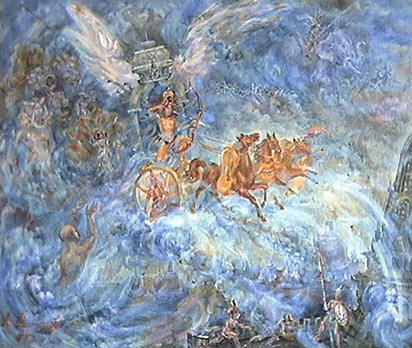
There was an asura named Tara whose son was Taraka. Tarakasuara went to a place named Madhuvana and began to perform very difficult tapasya. He gazed at the sun and stood there with his arms raised. He stood on one leg and only on the toes of his feet. A hundred years passed. For those hundred years, Taraka drank only water and had no food to eat. For the next hundreds, he gave up water also and lived only on air. A hundred years were spent in performing tapasya inside water, another hundred years on earth and a hundred years more inside fire. For a hundred years he performed tapasya upside down, standing on his hands. And for yet another hundred years, he hung upside down from the branches of a tree.
The meditation was so difficult that Lord Brahma was pleased. He appeared before Tarakasura and said, I am pleased with your tapasya. What boon do you want? If you are pleased, replied Tarakasura, grant me two boons. The first boon should be that no one created by you should be as strong as me. The second boon should be that I should be killed only by Shiva’s son. Shiva at that point in time had no sons. Sati had died and although she had been reborn as Parvati, she had not yet married Shiva. Brahma granted Tarakasura the two boons.
The demon went to a city named Shonitapura and began to live there. All the other demons made Tarakasura their king. Thanks to the boon, Tarakasura was so strong that he easily defeated his challengers, stealing all their belongings and employing them as his servants.
Tarakasura had three asura sons named Vidyunmali, Tarakaksha and Viryavana (tripurasuras). These three began to perform tapasya. For a hundred years they meditated standing only on one leg. For a thousand more years they lived on air and meditated. They stood on their heads and meditated in this posture for yet another thousand years.
Brahma was pleased at this difficult tapasya. He appeared before them and said, What boon do you want? Make us immortal, answered Tarakasura’s sons. I can’t make you immortal, replied Brahma. I don’t have the power. Ask for something else instead. Very well, then, said Viyunamali, Tarakaksha and Viryavana. Grant us the following: Let three forts be made. The first will be of gold, the second of silver and the third of iron. We will live in these forts for a thousand years. At the end of the thousand years, the forts will become one. This combined fort will be called Tripura. And if anyone can then destroy Tripura with only a single arrow that shall be the death destined for us.
This rather unusual boon Brahma granted. There was a danava named Maya who was very good at building work. Brahma asked him to build the forts. The golden fort was built in heaven, the silver one in the sky and the iron one on earth. Tarakaksha got the golden fort, Viryavana the silver one and Vidyunmali the iron one. Each of the forts was a big as a city and had many palaces and vimanas (spaces vehicles) inside.
The demons populated the three forts and began to flourish. The demigods did not like this at all. They first went to Brahma, but Brahma said he could not help them. After all, the demons had got Tripura thanks to his boon. The gods then went to Shiva for help. But Shiva said that the demons were doing nothing wrong. As long as that was the case, he did not see why the demigods were so bothered. They next went to Vishnu, who suggested that the problem was that the demons were doing nothing wrong, the solution was to persuade them to become sinners.
Out of his powers Vishnu created a man. This man’s head was shaven, his clothes were faded and he carried a wooden water-pot in his hands. He covered his mouth with a piece of cloth and approached Vishnu. “What are my orders?” he asked Vishnu.
Let me explain to you why you have been created, replied Vishnu. I will teach you a religion that is completely against the Vedas. You will then get the impression that there is no svarga (heaven) and no naraka (hell) and that both heaven and hell are on earth. You will not believe that rewards and punishments for deeds committed on earth are meted out after death. Go to Tripura and teach the demons this religion, which they are dislodged from the righteous path. Then we will do something about Tripura.
The being did as he had been asked to. He and four of his disciples went to a forest that was near Tripura and began to preach. They were trained by Vishnu himself. Therefore, their teachings were convincing and they had many converts. Even the sage Narada got confused and was converted. In fact, it was Narada who carried news of this wonderful new religion to king Vidyunmati. King, he said, there is a wonderful new teacher with a wonderful new religion. I have never heard before. I have got converted.
Since the great sage Narada had got converted.Vidyunmati also accepted the new religon. And in due course, so did Tarakaksha and Viryavana. The demons gave up revering the Vedas, they stopped worshipping Shiva’s linga.
Vishnu and the other gods then went to Shiva and began to pray to him. When Shiva appeared, they told him that the demons had now become evil and should be destroyed. They had even stopped worshipping Shiva’s linga.
Shiva agreed to destroy Tripura. Vishvakarma was the architect of the gods. Shiva called Vishvakarma and asked him to make a suitable chariot, bow and arrow. The chariot was made entirely out of gold. Brahma himself became the charioteer and the chariot was speedly driven towards Tripura. The gods accompanied Shiva with diverse weapons.
By then, a thousand years had passed so that the three forts had become a single Tripura. Shiva installed a divine weapon known as pashupata into his arrow and shot it at Tripura. The arrow burnt up Tripura into ashes in a split second. While the celebrations were going on, the shaven-heads religious teachers arrived. What are we supposed to do now? they asked.
Brahma and Vishnu told them to go and live in the desert. The last of the four eras was kaliyuga and in kaliyuga, evil would reign supreme. When kaliyuga arrived, they were to come back and begin their teaching afresh.
d) King Vikramaditya and Avantika
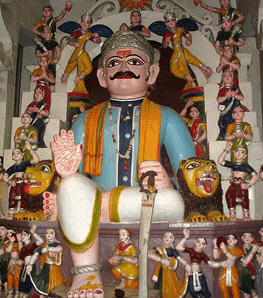
One of the most famous kings of Ujjain of his time was king Vikramaditya . He was famous for his kshatriya spirit and also great intelligence. His encounter with Vetal demon and his special simhasan are well known. The throne of Maharaja Vikramaditya, known as the “seat of judgment (salabanjika throne)” is said to be still located in the Rudra Sagarlake.
Bhadrakali – Ujjain – SrimadBhagavat 10th canto.
Lord Krishna to Yogamayadevi
O all-auspicious Yogamaya, I shall then appear with My full six opulences as the son of Devaki, and you will appear as the daughter of mother Yasoda, the queen of Maharaja Nanda.By sacrifices of animals, ordinary human beings will worship you gorgeously, with various paraphernalia, because you are supreme in fulfilling the material desires of everyone.Lord Krsna blessed Mayadevi by saying: In different places on the surface of the earth, people will give you different names, such as Durga, Bhadrakali, Vijaya, Vaisnavi, Kumuda, Candika, Krsna, Madhavi, Kanyaka, Maya, Narayani, Isani, Sarada and Ambika.
The names by which Mayadevi is known in different places have been listed by Vallabhacarya as follows. In Varanasi she is known as Durga, in Avanti she is known as Bhadrakali, in Orissa she is known as Vijaya, and in Kulahapura she is known as Vaisnavi or Mahalaksmi. (The representatives of Mahalaksmi and Ambika are present in Bombay). In the country known as Kamarupa she is known as Candika, in Northern India as Sarada, and in Cape Comorin as Kanyaka. Thus she is distributed according to various names in various places.
Srila Vijayadhvaja Tirthapada, in his Pada-ratnavali-tika, has explained the meanings of the different representations. Maya is known as Durga because she is approached with great difficulty, as Bhadra because she is auspicious, and as Kali because she is deep blue. Because she is the most powerful energy, she is known as Vijaya; because she is one of the different energies of Visnu, she is known as Vaisnavi; and because she enjoys in this material world and gives facilities for material enjoyment, she is known as Kumuda. Because she is very severe to her enemies, the asuras, she is known as Candika, and because she gives all sorts of material facilities, she is called Krsna. In this way the material energy is differently named and situated in different places on the surface of the globe.
SB 10.2.13 purport
Stories from Avanti Kshetrakhand -Skandapurana
Sanat Kumar glorifies Mahakaal Teertha
Once, goddess Parvati requested Shiva to describe the significance of Mahakaalteerth. Lord Shiva replied- “Once, Sanatkumar- one of the manasaputras of Lord Brahma had gone to his father’s abode, situated at a place near Meru mountain. Sage Vyas arrived there and asked him the same question. Sanatkumar had revealed to him that all kinds of sins lost their evil influence at Mahakaalteerth. He had also told him that it was called ‘Peetha’ because Matrikas had their abode over there. Anybody, who is fortunate of leaving his mortal body at this holy-place, is freed from the vicious cycles of birth and death. This place is very dear to Lord Shiva and is also called by various other names like Ekamrak-van, Mahakaal-van and Vimukti-kshetra.
Kapal Mochan
Once, lord Shiva arrived at Mahakal forest with a skull in his hand. All the trees and vegetation were delighted to find him in their midst. They requested lord Shiva to remain there forever. Lord Shiva told them that it was not possible for him to stay there forever, but on being requested once again,lord Shiva agreed to stay there for at least a year. After one year, when the time for departure came he released the skull from his hand as a memorial. When lord Brahma came to know of this incident, he instructed all the demigods to reach Mahakal forest without wasting any time so that a grand yagya could be performed at the place where Shiva had left the skull. All the demigods went to the place and worshipped Lord Shiva by employing the rituals of Pashupatvrata, which Lord Brahma had taught them. Lord Shiva became pleased by their devotion and said–’ Perhaps you all are not aware that there was a specific objective behind my act of releasing the skull from my hand. This act of mine was done to protect your lives but it seems you are unaware of its significance. In a way, all of you have already received my blessings in advance for your deep devotion. What else do you wish for?’ Demigods were amazed by Shiva’s statements and were wondering what Shiva was trying to convey. So, they requested Shiva to unravel the mystery so that they could understand what he meant. Lord Shiva told them-‘ The followers of Maya were planning to kill you while you were busy doing penance but none of you were aware of their evil motive. I came to know about this in my deep state of meditation and dropped the skull from my hand. As soon as the skull touched the ground a thunderous sound was made as the result of which all the demons were killed instantaneously.’
All the demigods thanked Lord Shiva for protecting their lives. In course of time this particular place became famous as Kapalmochan and is presently situated in Ujjain.
Various Names of Ujjainipuri
Once, sage Vyas requested Sanatkumar to reveal why Ujjainipuri was known by various names like Kanakshringa, Kushasthali Avanti and Padmavati.
Sanatkumar replied-‘Once, Lord Brahma and Lord Shiva arrived at Ujjainipuri in search of Lord Vishnu, who had disappeared from his abode. To their pleasant surprise they found Lord Vishnu staying there. Both of them requested Vishnu to allow them to stay at Ujjainipuri and said-‘ O Lord! When did you create such a magnificent place with golden mountain peaks? Allow us to live in this beautiful city for we cannot live in your separation.’
Lord Vishnu requested Brahma to make his abode in the northern part of the city while Shiva was told to make southern part as his abode. Lord Vishnu then told them-‘ Since you have referred to this place as a city of golden mountain peaks therefore from now onwards it would become famous as ‘KanchanShringa’ (golden peaks)’.
Sanatkumar then went on to explain why Ujjainipuri was also called Kushasthali- ‘Having created the world, Lord Brahma requested Lord Vishnu to nurture it. Lord Vishnu agreed on the condition that Lord Brahma provided him a pious place on the earth from where he could perform his duty. Brahma then picked up a handful of kusha grass and threw down on the earth. This way Lord Vishnu performed his duty as the nurturer of the world sitting on the seat of kusha grass. This is the reason why this place came to be known as Kushasthali.’
Sanatkumar then described how Ujjainipuri also came to be known as Avanti puri- ‘Once, after being defeated by the demons, demigods fled to Meru mountain. Later on they went to Lord Brahma and sought his help. Lord Brahma took all the demigods to Lord Vishnu. Hardly had they reached the abode of Vishnu and offered their obeisance when they heard a heavenly voice- ‘There is a sacrosanct place called Kushasthali in the forest of Mahakal van. This holy place is graced by the presence of Lord Mahadeva. Go there and engage yourself in austerities and you will certainly become the master of the heaven once again.’
Subsequently, all the demigods went to a place called Paishachmochan situated in Kushasthali and engaged themselves in various austerities. As prophesized by Vishnu, the demigods indeed defeated the demons and became the ruler of heaven. The term ‘Avan’ means ‘the protector’ and since it had protected the demigods hence it became famous as Avanti.
Sanatkumar also described how Kushasthali also came to be known as Ujjaini- ‘Once, a demon named Tripur did a severe penance to please Lord Brahma. When Brahma appeared, he expressed his wish of becoming immortal. Lord Brahma fulfilled his wish as the result of which Tripur became arrogant and started tormenting the demigods. The demigods sought the help of Lord Shiva, who assured them that he would kill the demon. Subsequently, Lord Shiva did kill Tripur with his most lethal weapon ‘pashupatashtra’ after a fierce battle. The place incident happened became famous as Ujjaini because of the fierce battle fought between Shiva and Tripur.
Continuing with the tale which described the reason why Ujjainipuri also came to be known as Padmavati, Sanatkumar told Vyas- ‘During the time of ocean churning ambrosia had also emerged from the ocean bed along with many other valuable things. The demons wanted to drink ambrosia so that they could become immortal but the demigods were against this idea. Very soon, the arguments turned into a major dispute and both the sides started quarrelling. Narada requested Lord Vishnu to do something in this regard. Lord Vishnu disguised himself as a beautiful lady and was successful in infatuating the demons. Finally, he started giving ambrosia to the demigods who after drinking it became immortal. A demon named Rahu, disguised himself, was sitting in the rows of the demigods. Lord Vishnu was unable to recognize Rahu and gave some ambrosia to him mistaking him to be a demigod. But, hardly had Rahu gulped down Ambrosia and before it could reach down his throat, Vishnu severed his head. Rahu’s head became immortal as the result of ambrosia’s influence. This incident had taken place at Mahakal forest. Later on all the demigods distributed the whole wealth, which had emerged from the ocean among themselves. This is the reason why Ujjainipuri came to be known as Padmavati because Padma is another name of Goddess Laxmi.
The Grandeur of Avantipuri
Sanatkumar says- ‘Once, Parvati requested Lord Shiva to explain why Avantipuri was considered so holy by the devotees. Lord Shiva told her that it was so because there were numerous holy places situated over there. Lord Shiva had told her-‘ There are four holy rivers flowing through the different regions of Avantipuri- Kshipra, Divya-nav, Neelganga and Gandhavati. There are temples belonging to eighty four Shivalingas, eight Bhairavas, eleven Rudras, Twelve Aadityas, six Ganeshas and twenty four goddesses. In addition, there are also temples of Lord Vishnu and Brahma. Avantipuri is spread in the radius of one yojan. There are temples belonging to ten different incarnations of Lord Vishnu- Vasudev, Anant, Balaram, Janardan, Narayan, Hrishikesh, Varah, Dharnidhar, Vaman and Lord Vishnu himself taking rest on Sheshnag. Also, there are many other holy places situated at Avantipuri, which enhances its sanctity and holiness.
